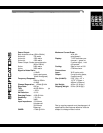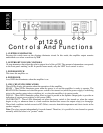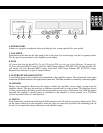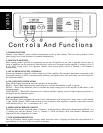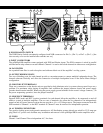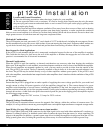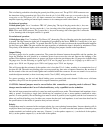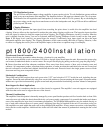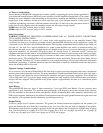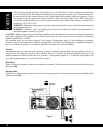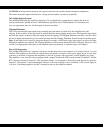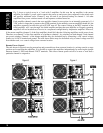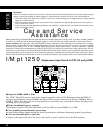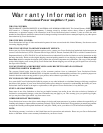
15
AC Power Considerations
Ensure that the pt1800/pt2400 is plugged into an outlet capable of supplying the correct voltage specified for
your model and enough current to allow full-power operation of all the amplifiers plugged into it. The current
demand of a power amplifier varies depending on several factors, including the impedance of the load, the
output level of the amplifier, and the crest factor and duty cycle of the program material. Under typical
conditions reproducing rock music, with both channels driven into a 4 ohm load to the point where musical
peaks are just at the clipping point, the amplifiers require the following average currents:
pt1800: amps for 120V versions, amps for 230V versions
pt2400: amps for 120V versions, amps for 230V versions
Safety Precautions
WARNING: IMPORTANT OPERATING CONSIDERATIONS FOR A.C. POWER SUPPLY CONNECTIONS.
VITAL SAFETY INSTRUCTIONS:
The pt2400/pt1800 have two separate A.C. power cords, each supplying power to one amplifier channel. Each
connection can draw up to 15 amperes of current, which is the maximum amount that can be supplied by a single 120
volt branch circuit. Therefore, the pt2400/pt1800 require TWO separate, independent branch circuits be provided; one
for each A.C. line cord. For a typical installation in a sound system amplifier rack, studio, or broadcast facility, you
must be sure that each power cord is plugged into its own branch circuit, just as if you were connecting two individual
high-power amplifiers. An electrician will refer to these AC branch circuits as “dedicated circuits”, because the
equipment connected to them (that is, each pt2400/pt1800 channel) will draw as much current as the circuit can supply.
It follows, then, that no other equipment may be connected to these same circuits because they are already loaded to
maximum capacity. The pt2400/pt1800 is not recommended for home installation, because the typical home will not
have two separate, dedicated A.C. circuits available in close enough proximity to allow proper connection. If domestic
installation is mandatory, a qualified electrician must be called upon to install two dedicated circuits into the location
where the pt2400/pt1800 is to be used.
Magnetic Leakage Considerations
If it is necessary to locate the pt1800/pt2400 in the same rack as signal processing equipment, then some consideration
must be given to their respective locations. The power amplifiers(s) should be mounted in the bottom of the rack. Space
may be required and should be allowed between the amplifier and signal processing equipment. Even though the
“Carver Magnetic Field” type power supply actually generates less stray magnetic field at idle than most conventional
designs, the stray magnetic field produced at full power output is approximately the same as a conventional power
supply design.
Input Wiring
The pt1800/pt2400 have two types of input connections: 3 pin type (XLR) and Barrier. Use the connector most
appropriate to your installation. For optimum input performance with respect to noise and common mode rejection,
drive the amplifier in the balanced mode configuration. Besides eliminating RFI (radio frequency interference) and
EMI (electro-magnetic interference), the balanced configuration allows the signal ground between the signal source and
the amplifier to be separated, thereby eliminating a potential ground loop.
Output Wiring
Use heavy gauge wire for speaker connectors. The greater the distance between the amplifier and the speakers, the
larger the diameter the wire should be to minimize power loss across the wire and improve damping of the speaker.
Wire thickness specifications (or gauges) get larger as the wire gets thinner; thus 14-gauge wire is thicker than 16-gauge
wire. Use the following as a guide: up to 25 ft. use 16 gauge, up to 40 ft. use 14 gauge, up to 60 ft. use 12 gauge, up
to 100 ft. use 10 gauge, up to 150 ft. use 8 gauge, up to 250 ft. use 6 gauge.



